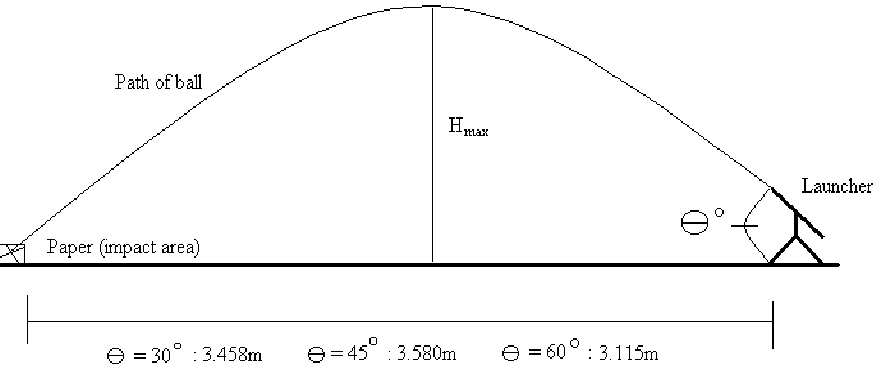Engineering Physics
Lab Report #4
Projectile Motion 2
Andy Buettner
Mr. Huttlin
![]() Objective
Objective
This lab is to study the projectile motion in which it starts at height = 0 and ends at the same height. The projectile, however, is launched at one of three fixed angles that are not = 0o.
![]() Materials
Materials
Spring launcher with built in protractor (same as lab 3)
Ball (same as lab 3)
Paper
Measuring apparatus
Meter stick
Tape Measure
Ink paper
![]() Procedure
Procedure
Set launcher from lab #3 on the floor.
Set the launcher to an angle of 30o.
Launch the ball and estimate the area of impact and the maximum height.
Place paper covered by ink paper over the area where the ball will hit.
Place a meter stick approximately where the height of the ball will be the maximum.
Launch the ball and use the meter stick to estimate the height obtained by the ball.
Record the mark made by the ball on the paper and the height obtained by the ball.
Repeat steps 6 and 7 two additional times.
Set the launcher to an angle of 45o.
Repeat Steps 3 through 8.
Set the launcher to and angle or 60o.
Repeat Steps 3 through 8 again.
Measure the distance between the launcher and the paper.
Measure the individual distances between the edge of the paper and the marks to find the total distance.
![]() Data
Data
Trial # |
1 |
2 |
3 |
|
Maximum Height |
69cm |
66cm |
67cm |
Total Distance Traveled |
358.8cm |
354.3cm |
348.2cm |
Trial # |
1 |
2 |
3 |
|
Maximum Height |
115cm |
112cm |
111cm |
Total Distance Traveled |
376.2cm |
370.2cm |
368.1cm |
Trial # |
1 |
2 |
3 |
|
Maximum Height |
156cm |
172cm |
159cm |
Total Distance Traveled |
313.6cm |
335.7cm |
317.5cm |
IV) Diagram 1:

![]() Analysis
Analysis
![]() Notice:
All calculations done on attached sheets!
Notice:
All calculations done on attached sheets!![]()
|
Result Table |
30 o |
45 o |
60o |
|
Ravg |
353.8cm |
371.5cm |
322.3cm |
|
Vm |
6.33m / s |
6.03m / s |
6.04m / s |
|
Havg (Observed) |
67.3cm |
112.7cm |
162.3cm |
|
Havg (Calculated) |
51.1cm |
92.9cm |
139.5cm |
![]() Conclusions
Conclusions
First, I would like to mention that this lab is not as accurate as lab 3 because there were no calculations for the initial height of the ball or the decreased muzzle velocity due to the acceleration of gravity. From this lab one could conclude that a projectile will follow a parabolic path through the air and will obtain maximum distance when launched at an angle of 45o, but maximum height.
![]() Answer
to Lab Questions
Answer
to Lab Questions
1) Q: What are the basic assumptions that are made about the vertical and horizontal components in order to solve a projectile motion problem?
A: First, in this experiment we assume that the initial height and distance is 0. Also, we assume that air resistance is negligible.
2) Q: Explain how air resistance affects the height and range of a projectile.
A: Air resistance decreases both values as well as causes the projectile to go off path.
3) Q: Compare the initial velocity with the ones in Lab 3. Why does the difference occur?
A: Two reasons: First of all, there was no calculation to include that the initial height was 0. Second, gravity was working against the accelerator.
4) Q: What angle gives the maximum range?
A: An angle of 45o.
Justified on paper.